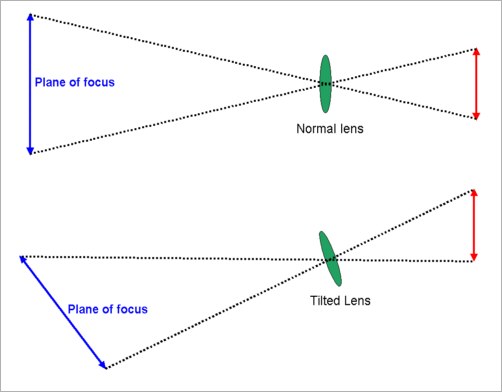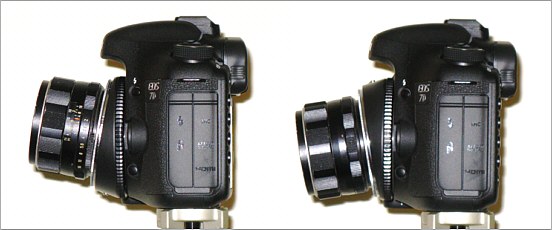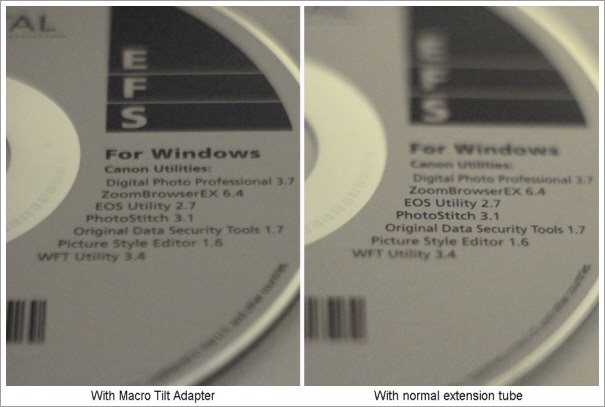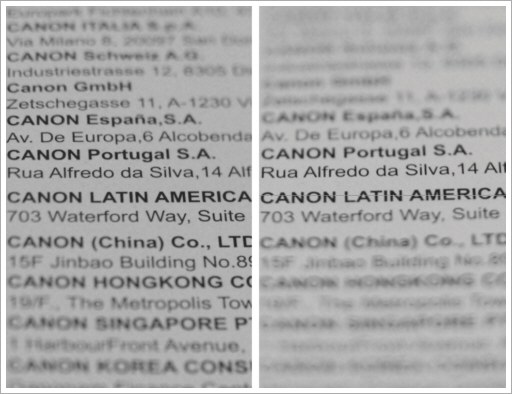

Canon EOS Macro Tilt Adapter

The idea behind this adapter (designed by Hartblei, a Ukrainian optics company) is the Scheimpflug principle, which describes the orientation of the plane of focus of an optical system when the lens plane is not parallel to the image plane. In simple terms, if the lens is tilted (up. down, right, left), the plane of focus also tilts. This is shown in the diagram below.

For the technically inclined (no pun intended) the angle of tilt of the lens (theta) is related to the angle of tilt of the plane of focus (alpha) by the relationship:
tan(theta) = (m+1/m)*tan(alpha)
where m is the magnification.
By tilting a lens you don't increase the depth of field, though sometimes it can appear that way. What you're doing is just tilting the plane of focus so that it more closely matches the plane of the object you're trying to get in focus in a photograph. This is more easily seen by example as shown below:
This adapter has a fixed angle of tilt - around 8 degrees - but that angle can be rotated so that the lens can point up, down, left or right (or anything in between!). There are click stops at 30 degree angles, but you can rotate the adapter between the click stops if you wish.

Left: tilted up, Right: 180 degrees rotation to tilted down
On one side of the adapter is a standard Canon EOS lens flange so the adapter mounts on the camera just like a normal lens. The other side of the adapter has a standard EOS body mount so you can mount any canon lens onto it. However - and here's the rub - there are no electrical contacts. Now no contacts isn't a problem for focus because you can (indeed you have to) use manual focus. However it is an issue when it comes to aperture. You can't change the aperture setting of an EOS lens unless there's an electrical contact with the camera. Consequently, if you mount any EOS lens on this adapter it will be wide open. Since this is a macro only adapter (more on this below), you'd almost always want to be stopped down. Now you can stop down an EOS lens by the following procedure:
- Mount the lens on the EOS body and set the aperture as normal
- Press the DOF button to stop the lens down to the set aperture
- While still holding down the DOF button, press the lens release button and remove the lens from the camera.
- The lens will now be stopped down to the selected aperture
The solution of course is to mount some other lens (which can be manually stopped down) via an adapter. For example you could mount an older Pentax M42 screw mount lens to a screw mount to EOS adapter, then mount that assembly onto the macro tilt adapter. But that begs the question of why you'd want an EOS mount on there in the first place!
The adapted M42 lens route works very well and with it the adapter is easy to use - for macro work. Why only for macro work? Well, the tilt adapter sits between the lens and the camera body and it's something like 1cm thick, so it acts like a 1cm extension tube. Lenses on extension tubes won't focus to infinity, so they can only be used for relatively close subjects.
Well, that's the theory so how does it work in practice? The answer is that it does what it does quite well.

These images were cropped and downsized from shots taken with a Pentax 55mm f2 lens (at f2). With the normal extension tube (12mm) the lens is parallel to the plane of the sensor and the subject it tilted. The zone of sharp focus is narrow. With the macro tilt adapter the lens is tilted down and the focus plane is closer the the focal plane of the subject. Normally for macro work I'd stop the lens down to f11 or maybe f16 and that would make the sharp parts of the image sharper, but the effect is easier to see at a wide shooting aperture.
The macro tilt adapter can, of course, be used in conjunction with normal extension tubes for greater magnification. The higher the magnification the smaller the DOF and so the more useful the ability to tilt the plane of focus becomes.
It's also possible to "reverse tilt" the adapter, i.e. to adjust it to create a smaller apparent DOF as shown in the images below:

On the left the adapter was rotated to give a plane of focus close to that of the subject, while on the right it was rotated through 180 degrees so as to minimize the area of the subject in focus. This can be useful for special effects and where you are trying to isolate a part of the subject by blurring the rest.
So the bottom line on the EOS macro tilt adapter is that it works as promised and can be a useful aid for modifying the focal plane when doing macro work. There are three issues to be aware of though.
- First this is a MACRO adapter and you won't be able to use it for portraits etc. With a 50mm (pentax) lens mounted, the maximum focus distance was about 10 inches from the front of the lens. You'll get an even shorter working distance with shorter focal length lenses and a longer working distance with longer focal length lenses. For example with a 300mm lens the maximum focus distance is around 25ft.
- Second the tilt angle is fixed which makes it harder to adjust for a particular effect. You have to optimize the camera position and use a fixed tilt angle rather than just optimize the tilt angle.
- Third the use of Canon EOS EF series lenses is difficult because of the lack of aperture control. Life is much easier when using older manual focus lenses with manual aperture control, adapted to an EOS mount.
Note that since most lenses are not built for tilting/shifting they have an image circle which only just covers a full 35mm frame. If you tilt the lens enough you may see vignetting or at the least significantly degraded edge quality. However if the adapter is used with a full frame lens and mounted on a crop sensor camera, this effect is greatly diminished since the lens has an image circle significantly larger than the camera's APS-C sized sensor.
For full frame sensors and/or to get focus ability at all distances (out to infinity) the best route would be to use a medium format lens on a suitable adapter. Kievcamera (see below) have such an adapter which is similar to the one described here except that on the lens side is a mount for Pentacon Six medium format lenses. An interesting combination might be the Pentacon Six mount tilt adapter ($129) with an Arsat 2.8/80 mm lens ($70). I haven't yet tried that combination, but it looks like it might do the job.
Acknowledgement
I'd like to thank KievCamera (kievcamera.net) for making this adapter available for review.
